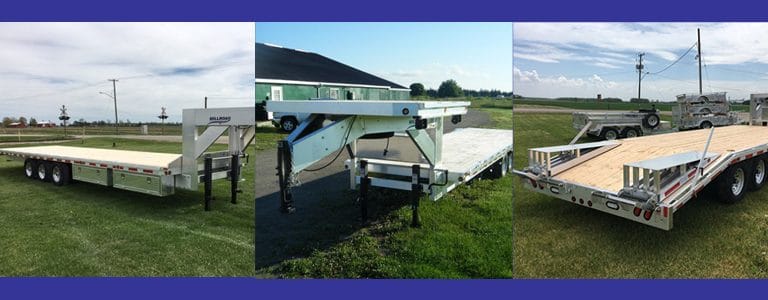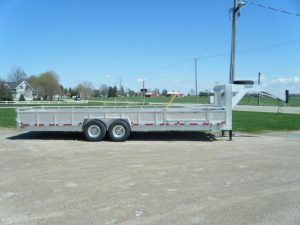
March 26, 2020 Last updated on June 16, 2023 by Bob Fisher Bob Fisher Gooseneck/Fifth Wheel Trailers
If you have to tow something weighing more than 30,000 pounds, such as a recreational vehicle or a loaded horse trailer, you need either a gooseneck trailer or a fifth wheel, plus a compatible Class V hitch to pull it. Gooseneck and fifth-wheel trailers do not hitch onto the back of a vehicle like smaller typically trailers do. Rather, they fasten onto a hitch installed into the cargo bed of the pickup. This makes it easier for the trailer to make tight turns.

Where gooseneck and fifth-wheel trailers primarily differ is the mechanism by which they connect to the trailer. A fifth-wheel uses a kingpin and a receiver, while a gooseneck hitch connects via a ball and coupler.
Each system has its strengths and weaknesses. For example, a gooseneck hitch weighs little, is relatively easy to operate, and is minimally invasive. However, it can be noisier than a fifth wheel, and the taller the trailer, the less stability you are likely to have. If you use your pickup primarily for towing, a fifth-wheel hitch may be the better option. However, if you use your truck for other tasks at least as often as for towing, you may prefer a gooseneck trailer because it takes up less space in the truck bed.
The decision-making process is not over once you decide on a gooseneck hitch. There are multiple varieties available, and the type you choose depends on several different factors. To help make it easier for you, here is an overview of the three types of hitches for gooseneck trailers and the benefits and drawbacks of each.

As the name implies, this type of gooseneck hitch installs underneath the bed of the pickup. Therefore, it requires creating a hole in the floor of the truck bed through which the ball of the hitch will extend into the cargo area. However, this hole is relatively small, usually no more than 4 inches.
Most under-bed gooseneck hitches do not require drilling of the vehicle frame. Rather, they are custom-fit for each vehicle. Some varieties of under-bed gooseneck hitches allow you to either remove the hitch ball when not in use or else lower it down so that it is flush with the floor of the truck bed.
This type of gooseneck hitch is similar to a fifth-wheel hitch in that it sits in the bed of the pickup and attaches to the same rails. This makes it the simplest type of gooseneck hitch to install. It can also be removed easily if you need more room in the bed of your pickup or if you need to switch out a different type of hitch.
A fold-down gooseneck hitch is similar to an above-bed hitch in that it is mounted on a plate in your truck bed. However, it is also similar to an under-bed hitch in that it requires the installation of rails below your truck bed. The distinguishing feature of a fold-down hitch is that the ball has the ability to fold down out of sight when not in use. For this reason, it requires you to cut a hole in the bed of your pickup. The hole required for a fold-down hitch is larger than that for an under-bed installation.
Goosenecks and fifth-wheel trailers both allow you to keep your load steadier and haul greater weights than a bumper pull trailer would allow. Whether you are involved in farming, commercial uses, or hauling as a hobby, a gooseneck trailer and associated hitch from Milford Manufacturing, Inc. is something you should consider.